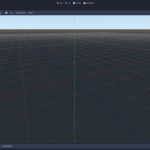Creating an RPG is no small feat. It’s a journey of exploration and creation that requires patience, creativity, and an understanding of what players truly seek.
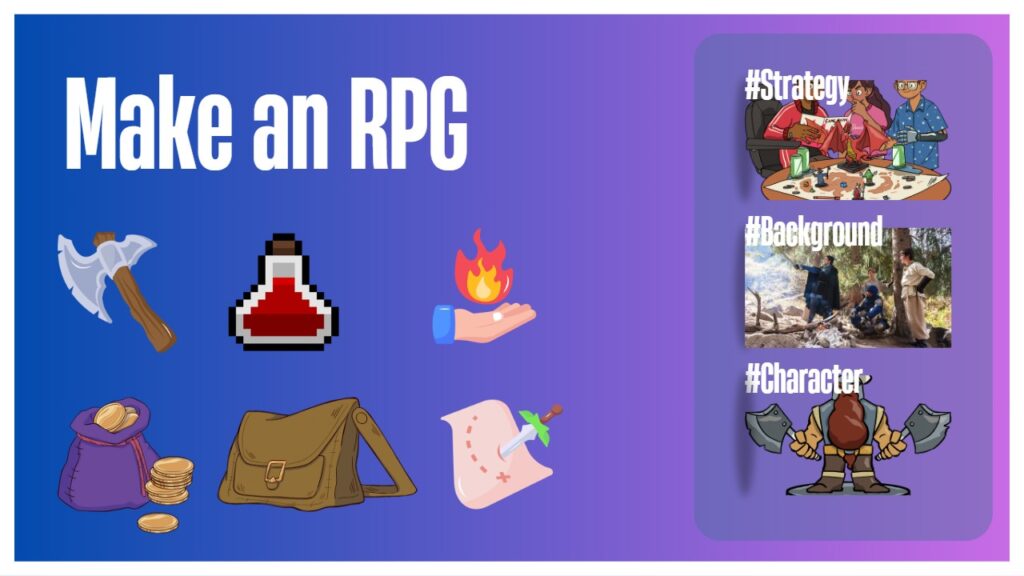
Table of Contents
Essential Features of an RPG Game
Immersive Worlds and Engaging Storylines
No RPG can rise above mediocrity without a captivating narrative and an immersive world. This aspect forms the foundation of the player’s experience. It’s the very essence that binds them to the game, a thread woven through every quest and character interaction. Think of it as the rich tapestry upon which the entire game will rest.
Spend time carefully crafting this world. Your landscape should feel alive, with ecosystems, cultures, and histories that give it depth and texture. As the player, they should feel like an explorer in uncharted territory, unveiling secrets and making meaningful connections as they traverse through your universe.
The storyline isn’t just about progressing from point A to point B. It’s a journey, filled with twists, turns, trials, and triumphs. It’s about making difficult choices that bear consequences, all while facing the greatest adversaries. When handled with skill, a compelling storyline can turn a good RPG into an unforgettable one.
Character Development and Customization
Creating memorable characters is a fundamental aspect of RPG game development. The game’s protagonists aren’t just avatars for the player. They’re a means for them to immerse themselves in your world. Customization allows the player to see themselves reflected in the game, reinforcing their connection to your world.
So, how do you achieve this? By creating a robust character creation system that allows players to modify their appearance, skills, and attributes. Moreover, consider the role of character progression. A well-structured leveling system and clear skill trees help players see their growth and achievements, encouraging further gameplay.
Remember, emotional resonance matters. As the game progresses, players should have opportunities to delve into their character’s story, personality, and motivations. Develop well-rounded characters with intriguing backstories and let their personal journeys parallel the overall narrative arc.
Dynamic Combat System
While an RPG’s heart may lie in its story, its pulse is often dictated by its combat system. Whether it’s the clash of steel or the crackle of spell-fire, combat forms a large part of the RPG experience. But remember, it’s not just about who can hit the hardest or cast the fastest.
Strive for a combat system that balances strategy, skill, and spectacle. It should present players with varied challenges that force them to adapt, think, and experiment. And importantly, it should feel satisfying. The thrill of victory or the tension of a close call can be just as immersive as any plot twist.
Give players tools to experiment with different strategies. Allow them to combine abilities in novel ways or use the environment to their advantage. Additionally, consider the visual and audio feedback. A rewarding combat experience isn’t just tactical, it’s visceral.
Balanced Progression and Reward System
RPGs are about the growth – of characters, skills, and narratives. To reflect this, developers should focus on building a balanced progression and reward system. Players need to feel a sense of accomplishment, a tangible indicator that they are improving, evolving, and getting stronger.
A well-implemented progression system provides a steady stream of challenges matched to the player’s level. It offers players the motivation to improve their characters, seek out new quests, and overcome stronger adversaries.
The reward system is equally important. Whether it’s new equipment, advanced skills, or narrative progression, rewards should always feel meaningful. They should reflect the player’s efforts and inspire them to continue their journey, regardless of the obstacles in their path.
Steps to Develop an RPG Game
Discovering Your Core Concept
Begin by diving headlong into the pool of creativity that is your game idea. This isn’t about the nitty-gritty of character classes or complex combat mechanics just yet. Instead, focus on the overarching story, setting, and themes. What world does your RPG inhabit? What stories are waiting to be told?
Spend time letting your ideas flow and expand, jotting down any thoughts that pop into your head. This stage isn’t about making final decisions, but rather exploring the potential of your RPG game. It’s akin to laying out all the puzzle pieces before you start putting them together.
Sculpting the Narrative
As we step into the realm of storytelling, remember, your plot is not a rigid edifice, but a living, breathing entity that grows and evolves as the player progresses. RPG games thrive on rich narratives. It’s essential to have a compelling storyline that weaves seamlessly with the gameplay.
Create a plot that keeps your players hooked, be it an epic quest to save the world, a thrilling adventure full of unexpected turns, or a deeply personal character journey. Build a dynamic world with a cast of complex characters who evolve as the story unfolds. Remember, your characters are the touchpoints for your players in this world, so make them engaging, relatable, and unforgettable.
Designing Mechanics
Now, let’s shift gears and delve into the mechanics of your RPG game. In this phase, the questions you want to address include: What’s the combat system like? How does character progression work? What kind of skills and abilities can players choose from?
Make your mechanics unique and interesting, yet intuitive enough to not overwhelm the players. Keep in mind that the game’s mechanics should serve the narrative and world-building, not overshadow them. They’re the backbone of your game, the systems that allow the story to unfold interactively.
Building the World
Take a moment to let your imagination roam free at this stage. You are the architect of your game world. What does it look like? Is it a sprawling city with neon lights and futuristic technology, or a magical land with dragons and enchanted forests?
Your game’s environment is more than just a backdrop—it’s a character in its own right. It’s where your story unfolds and where your players will spend their time exploring, battling, and experiencing the narrative. Make sure the world is detailed, immersive, and filled with opportunities for interaction and exploration.
Adding the Artistic Touch
There’s something magical about art in RPGs. It brings your game to life and pulls players into your meticulously crafted world. Character designs, environments, soundtracks – every creative element helps shape the player’s experience.
Remember, the art style and soundtrack should complement your narrative and game mechanics, forming a harmonious whole. Whether you’re working with pixel art or high-definition 3D models, make sure it all fits together in a coherent, pleasing manner.
Testing and Polishing
Your game needs rigorous testing. This involves running through the game multiple times, identifying bugs, and smoothing out gameplay issues. Consider feedback from your test players as they can provide insights you might miss.
Testing is not just about fixing bugs—it’s also about fine-tuning the player experience. Does the story flow well? Is the combat satisfying? Do the puzzles make sense? The answers to these questions will help you polish your game to perfection.
RPG Mechanics
- RPG SKill Algorithms and Concepts: Understanding skill algorithms is an integral part of developing RPG games, creating a captivating and immersive gaming experience. The most intricate and strategic combats often involve status effects more than mere damage infliction. However, devising innovative and impactful status effects can be a tricky task. Should you opt for traditional ailments such as poison or paralysis or experiment with something novel? Additionally, how can you ensure your buffs are as engaging as your debuffs? Engage with other users on this forum post discussing the process of creating skills inclusive of attributes and status effects.
- Simple RPG Algorithms: Establishing the relationship between attack, defense, and other attributes that rely on basic stats can be a challenging task. The four basic stats, strength, constitution, intelligence, and dexterity should grow gradually and logically. A well-thought-out system ensures balanced and efficient attribute growth.
- Using the Composite Design Pattern for an RPG Attributes System: In addition to devising an engaging and original concept, you need to design intricate gameplay mechanics for long-term player engagement. For RPGs, creating a realistic and consistent system for calculating attributes like intelligence, charisma, wisdom, and willpower becomes vital. The Composite Design Pattern is an effective way to approach this. It allows you to develop complex objects from simpler ones. This tutorial on the Composite Pattern can be your aid to deal with attribute calculations, leading to a balanced and consistent game.
- Using the Composite Design Pattern for an RPG Attributes System: In games like Idle RPG and Tap RPG, your character’s abilities and progress are heavily influenced by certain numbers. These numbers play a role in different aspects of the game. For example, your character’s strength determines how much damage they can deal with, and this is further enhanced by the damage value of their weapon. The numbers also affect your character’s health and mana pool. However, programming these large numbers can be tricky because there is a risk of the data becoming too large for the system to handle. That’s why it’s important to use a programming language that can effectively manage these large numbers. This forum post is a discussion about how to program and handle these numbers in the game, and how they impact gameplay.
- How to create a scalable MMORPG server-side: Designing a server-side system for MMORPGs that can handle a large number of players requires careful thought. Firstly, choosing the right architecture for your game is extremely important. There are various options available, each with its own pros and cons. Furthermore, it is essential to be aware of potential performance problems that may arise when using certain programming languages and technologies. Seeking advice from experts in the field can offer valuable insights into the most suitable technologies to employ. Join this ongoing discussion to gain further knowledge on this topic.
Best Game Engines to Make an RPG Game
Unity
The go-to for many indie developers, Unity, is a versatile engine that offers a balance between usability and depth. Unity’s user-friendly interface and extensive documentation make it a favorite among beginners and seasoned developers alike. Its wide range of plugins and prefab assets from the Unity Store can also speed up development.
Its flexibility doesn’t stop at 2D games either. Unity has a robust system for creating 3D worlds, making it an excellent choice for developers aiming to create an immersive, 3D RPG. Furthermore, its cross-platform capabilities allow developers to reach a wide audience, from PC to consoles and mobile devices.
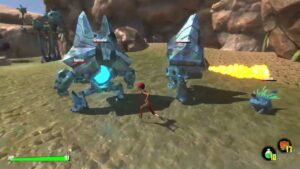
ORK Framework 3 is a comprehensive toolset for RPG creation that provides multiple customization options. Key features include a flexible status system, four distinct battle systems (Turn-Based, Active Time, Real-Time, and Phase), an inclusive inventory system with optional slots and limits, and a variety of player and camera controls.
Additionally, it has a robust editor for system setup and data creation, a modular UI system for designing dialogues, menus, and HUDs, and a formula system to compute game mechanics like damage or turn order.
You know, this toolkit is seriously awesome. One of the coolest things about it? You can just pick and choose the parts you need. That’s a huge win right there! Plus, it’s always getting better, thanks to regular updates.
And don’t worry if you’re just starting out, they’ve got you covered. There are super easy-to-understand tutorials for every part of the toolkit. Plus, the editor is a dream to work with. Each function has this handy tooltip to guide you. No more guessing what each button does!
The user manual might be a bit on the short side, but don’t let that scare you. The support? Absolutely top-notch. If you ever have a question or hit a snag, just pop over to the official forum. The developer is there pretty much daily, ready to help out. It’s pretty sweet, actually!
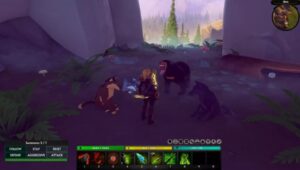
This kit is packed with 31 unique modules specifically tailored for RPGs, designed to provide you with all the tools you need. One of the key features is full access to the underlying code, so you can learn from it or even expand upon it to suit your game.
Along with this, the kit includes more than 32 premium-quality humanoid animations to bring your characters to life. For those who are new to the RPG creation world, there’s a wealth of over 100 instructional videos available on YouTube to guide you through the process.
The integrated third-person action RPG character controller provides a dynamic gaming experience. Moreover, this kit is the product of collaboration with 11 partners, enhancing its diversity and scope.
Unreal Engine
If you’re aiming for a high-fidelity, 3D RPG, then Unreal Engine might be the choice for you. Unreal is known for its ability to produce stunning graphics and complex simulations. Big names like the Final Fantasy and Kingdom Hearts franchises have used Unreal Engine 4 to create their RPGs, demonstrating the engine’s capabilities.
Unreal Engine’s Blueprint system allows developers to create gameplay elements without writing code, perfect for those less experienced in programming. However, it’s worth noting that to truly tap into Unreal’s potential, some knowledge of C++ will be necessary.
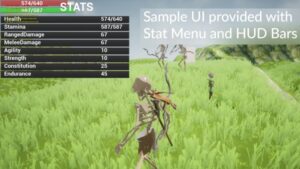
The Advanced RPG System (ARS) is an easy-to-use plugin for the Unreal Engine that assists game creators in designing intricate RPG elements.
Being component-based, ARS fits seamlessly into any game, offering an effortless setup. It lets you create custom attributes (like strength), statistics (like health), and parameters (like damage), enabling a personalized gaming experience.
ARS offers unique ways to set relationships between attributes. It also provides an attribute modification feature for real-time adjustments. Moreover, it offers two level-up options – an automatic one based on predefined rules, and a perk-based system that awards perks for enhancing attributes.
Designed with online gaming in mind, ARS ensures smooth multiplayer experiences. While it’s written in C++, it’s accessible through Blueprints, meaning you can use it without writing code.
Flutter
Flutter is a popular and powerful framework for creating mobile applications. Although it’s not typically associated with game development, it can be used for this purpose, including for creating Role-Playing Games (RPGs).
However, there are certain limitations, and it might not be the best choice for complex or 3D RPGs, which are typically made using dedicated game development engines such as Unity or Unreal Engine.
If you want to learn more about Flutetr game development, you can visit Games in Flutter website for tools and showcases.
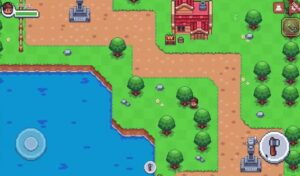
Bonfire is a versatile game kit built on the Flame engine, enabling you to design a variety of games with ease. Its adaptability extends to RPGs, real-time strategy games, first-person shooters, and more, offering endless possibilities.
It supports different perspectives, allowing the creation of games ranging from top-down action RPGs like “The Legend of Zelda: Breath of the Wild” to traditional JRPGs similar to “Final Fantasy VI”.
Additionally, Bonfire can also be used for strategy RPGs, tactical RPGs, point-and-click adventure games, and platformers.
Godot
Godot is an open-source engine that has been gaining traction in the indie game development scene. The engine offers a unique scene-based design methodology that allows for flexible and organized game architecture.
Godot is lightweight. It’s quick to install and runs smoothly on most systems. Plus, its open-source nature means the engine is consistently updated and improved by its community.
For 2D RPG development, Godot is one of the best out there. The engine’s 3D capabilities are improving with each update but currently lag behind Unity and Unreal.
RPG Maker
RPG Maker is a series of engines specifically designed for RPG creation, making it a good choice for beginners or those looking to create a classic, JRPG-style game.
With pre-made assets and a user-friendly interface, developers can create a functional RPG without touching a line of code.
While RPG Maker doesn’t offer the flexibility or depth of engines like Unity or Unreal, its accessibility, and simplicity make it an attractive choice for hobbyists and solo developers.
The engine’s latest iteration, RPG Maker MZ, has enhanced features and improved customization.
Three.js
Three.js is a popular JavaScript library used for creating 3D graphics in the browser. It provides a high-level interface to WebGL (Web Graphics Library), which is a low-level API for rendering 2D and 3D graphics. Three.js simplifies the process by providing a set of ready-to-use functions and objects, such as materials, lights, and geometries, which can be used to create complex 3D scenes with less effort.
You can absolutely use Three.js to create RPG (Role Playing Games) games. It provides you with the tools to create the 3D environments, characters, and props you might need for your game. However, it’s important to note that Three.js is primarily a graphics library. While it provides the tools for creating and manipulating 3D graphics, it does not include out-of-the-box solutions for things like game physics, AI, or game logic.
I Tried Making a 3D RPG Game in JavaScript
This guide is an introduction for novices who are interested in crafting 3D games using JavaScript. It demonstrates the process using Three.js, a free-to-use toolkit that simplifies the development of such graphic content!
GameMaker Studio 2
GameMaker Studio 2, while not specific to RPGs, is known for its intuitive design and powerful scripting language (GML). This engine is a popular choice for 2D game development, including RPGs. Its Drag and Drop feature is a boon for those without a programming background, but to unlock its full potential, diving into GML is recommended.
Its marketplace offers a variety of resources to speed up development, from sprites to scripts. While its 3D capabilities are somewhat limited, it’s a robust tool for creating compelling 2D RPGs.


